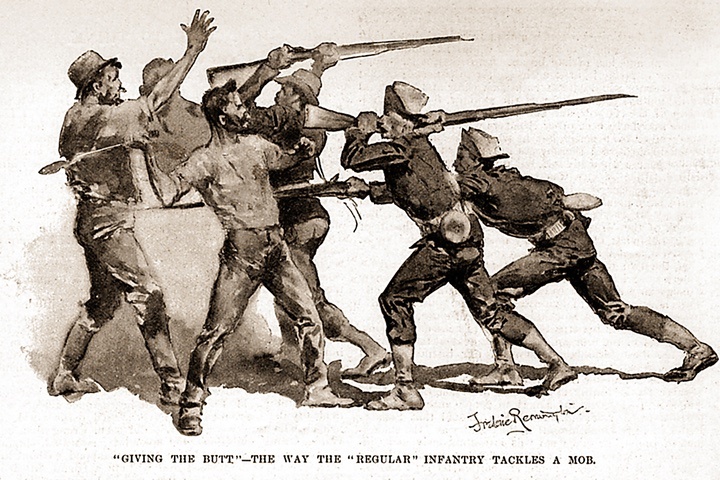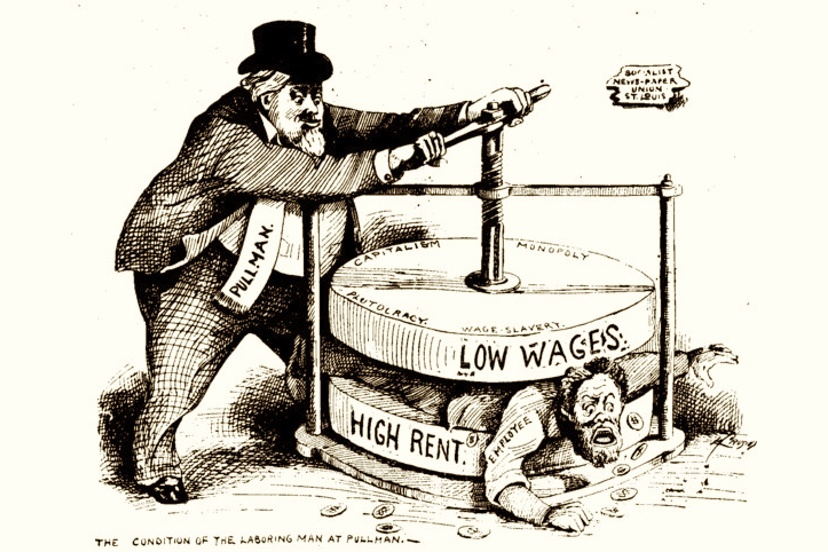This Labor Day, you can score a ton of deals and discounts on tech products such as headphones and earbuds.
— from ‘Top 5 sales to shop on headphones and earbuds this Labor Day’ by Casey DelBasso, on ABCNews.go.com, August 30, 2024.
The article mentioned above, on the ABC News website, provides links to earbuds and headphones available at two online outlets — Best Buy and Amazon — at Labor Day prices. You can get the Apple Max Wireless Over-Ear Headphones, normally priced at $549, for just $399. At the other end of the pricing spectrum, you can order the Soundcore P20i True Wireless Earbuds for just $19.99 (regular price, $39.99).
Although these products were not assembled by American workers, they will be delivered to your door or mailbox, within a few days, by American workers.
I suspect very few shoppers will be considering that these Labor Day sales have a distant relationship to the Pullman Strike in 1894, during a deep economic depression. In a sense, the right to celebrate Labor Day was paid for in blood.
In the late 1800s, at the height of the Industrial Revolution, the average American worked 12-hour days and seven-day weeks in order to eke out a spartan living. Despite restrictions in some states, children as young as 5 or 6 toiled in mills, factories and mines across the country, earning a small fraction of an adult wage.
So it may have struck folks as ‘revolutionary’ when, on September 5, 1882, 10,000 New York City workers took unpaid time off to march from City Hall to Union Square, to hold the first Labor Day parade in U.S. history — followed by a picnic.
Five years later, Oregon became the first state to make Labor Day an official public holiday. By 1894, thirty U.S. states were officially celebrating Labor Day. But the federal government had not yet endorsed a proposal by Grover Cleveland, that establishing a labor holiday in September would draw attention away from the annual socialist-inspired International Workers Day celebrations on May 1.
In the spring of 1894, the Pullman railroad car manufacturing company had pushed its workforce into despair, following the Panic of 1883. George Pullman had created a ‘company town’ on Chicago’s south side, where the employees worked and lived — and paid rent, and shopped at the company store. When the sales of Pullman Palace rail cars dried up as a result of the economic depression, George Pullman reduced his workers’ wages 20% to 30%.
From Wikipedia:
However, he did not cut rents nor lower prices at his company stores, nor did he give any indication of a commensurate cost of living adjustment.
The employees filed a complaint with the company’s owner, George Pullman. Pullman refused to reconsider and even dismissed the workers who were protesting. The strike began on May 11, 1894, when the rest of his staff went on strike.
In sympathy with the Pullman employees, the newly formed American Railway Union had come to Pullman and signed up many of the disgruntled factory workers. After the Pullman Company refused recognition of the ARU or any negotiations, the ARU called a massive boycott against all trains that carried a Pullman car — which affected most rail lines west of Detroit and at its peak involved some 250,000 workers in 27 states.
The federal response to the strike was handled by U.S. Attorney General Richard Olney, backed by President Cleveland and his administration, justified by the claim that the boycott was preventing the movement of the U.S. mail. When the strikers ignored a court injunction, thousands of U.S. Marshals and 12,000 U.S. Army troops participated in breaking the boycott.

The arrival of the military and the subsequent deaths of workers led to further outbreaks of violence. During the course of the strike, at least 30 strikers were killed and at least 57 were wounded.
Subsequently, President Cleveland signed a bill making the first Monday in September a federal holiday, but this applied only to federal employees. As late as the 1930s, unions were encouraging workers to strike to make sure they got the day off on Labor Day.
That’s information I found online, leading up to Labor Day 2024.
I also found Labor Day sales.

Labor Day marks the last holiday weekend of the summer, and the last big chance to save before Black Friday. So, in between road trips, beach days and barbecues, you may want to take a look at some of the Labor Day sales happening across the web…
The Target Labor Day Sale kicked off on Saturday and goes through today, Monday, September 2, where you can get up to 50% off of home goods, apparel, tech, groceries and more.
Although none of the items are made by American workers, we have our choice of headphones, iPads, and vacuum cleaners — and wearing the latest clothes and shoes, made in Asia, as we vacuum the living room listening to our favorite tunes on our new headphones (thanks to noise-cancelling technology…)
Still struggling with low wages? Maybe not, if you’ve landed a job designing websites that promote Labor Day sales. We can keep the economy going. We just need to get comfortable paying ever-higher prices for rent, and utilities, and food, and taxes… and of course, consumer products.

